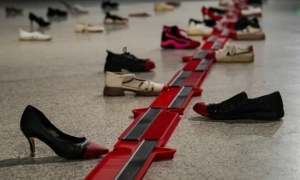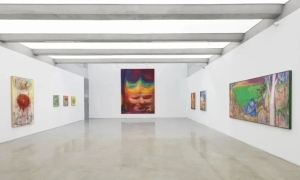9月25日(本周二),十几名艺术团体BBZ London的成员和其他活动家穿着印有“别拿黑人的痛苦赚钱”的T恤在泰特不列颠美术馆2018年特纳奖开幕式上发起了一场行动,抗议新西兰艺术家卢克·威利斯·汤普森(Luke Willis Thompson)的《自拍像》(2017)入围特纳奖。该团体的Instagram称,他们决定针对该作品以及非黑人艺术家和艺术机构利用黑人创伤赚取文化和财务利益的行为采取一种“象征性的反对立场”。
卢克·威利斯·汤普森在泰特美术馆放映特纳奖入围作品 图片来源: Dinendra Haria/Rex/Shutterstock
汤普森的《自拍像》是一件黑白无声的影像装置,画面里的人物戴蒙·雷诺(Diamond Reynolds)2016年曾经在Facebook上直播男友费兰多·卡斯蒂利亚(Philando Castile)在开车过程中被警察叫停,最后被开枪射杀的全过程。这件作品自从去年在伦敦Chisenhale画廊的艺术家英国首场个展中第一次展出以来,人们对它的评价一直褒贬不一。
问题的核心在于,被抗议团体定性为“跟白人毫无二致”的汤普森自我定位却是黑人,只不过不是“非洲裔离散群体”。(他是斐济和欧洲混血。)在2017年8月17日的一次采访中,汤普森承认,创作《自拍像》以来一直咬住他不放的一个问题就是,“你以为你自己是谁,能做这件作品?”
BBZ London成员雷尼·马蒂奇(Rene Mati?)在5月发表于网站Gal-Dem上的一篇文章中写道,汤普森自己的身份认同并不能改变如下事实,即他“实际上与白人并无区别,而且在利用黑人以及边缘群体经受的磨难与暴力创作作品,赚取利益。”汤普森今年早些时候获得了德国证交所摄影奖(Deutsche B?rse Photography Prize)4万美元的奖金,如果被评为特纳奖获得者还将得到3.3万美元奖金。
马蒂奇认为汤普森沉迷于种族暴力,对他其他几件类似作品也提出了疑问,比如他2015年参加新美术馆三年展的作品。在该作品中,观众被邀请跟随一名黑人导游,徒步从曼哈顿走到布朗克斯。
据《卫报》报道,泰特不列颠美术馆馆长亚历克斯·法尔哈森(Alex Farquharson)称,本届特纳展是泰特美术馆历史上最具政治性的一场展览。“让人感觉真是最符合我们这个时代的一次特纳奖。我认为在所有层面上,在欧洲,在美国,在世界很多地区,现在都是最政治的一个时刻。”馆方目前尚未回应artforum.com就美术馆如何看待此次抗议提出的询问。但泰特公布了如下声明(英文):
#cutoff#
“At 21.20 on Monday 24 September a small group of visitors wearing identical t-shirts sat on the sofas in the Turner Prize exhibition foyer. They sat in silence for a few minutes and then left the gallery.
“Luke Willis Thompson does not identify as white, he is originally from New Zealand, of Polynesian heritage and is mixed race. This trilogy of work by Luke Willis Thompson reflects his ongoing enquiry into questions of race, class and social inequality, which is informed by his own experience growing up as a mixed-race person in New Zealand. These films were made in the shadow of the Black Lives Matter movement and the artist sees his works as acts of solidarity with his subjects. He links his own position as a New Zealander of Fijian descent, treated as a person of colour in his home country, to that of other marginalised and disempowered communities. He finds ways of suggesting connections while also acknowledging the limits of what we can know of another’s pain, and how it can be represented.”




























